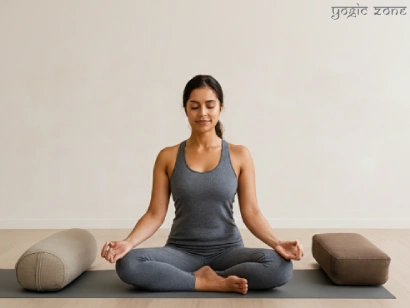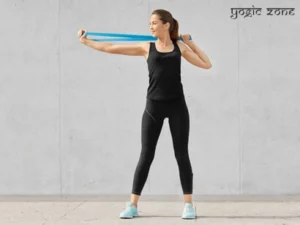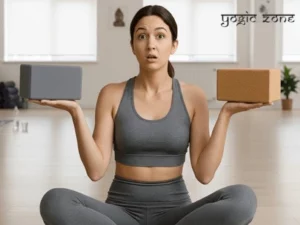
PhD candidate in Yoga | Co-Founder Yog Association Banaskatha | National Yoga Referee | Ministry of Ayush Yoga Instructor | Secretary Yog Association Ahmedabad | Master’s in Yogic Art | Know more about Milan Rao
When I first started yoga, I quickly realised that props could transform my experience—especially the yoga bolster. If you ever find yoga too challenging or not relaxing enough, let me share how this prop has brought comfort and support into my own practice and how it can do the same for you.
I remember my gurus introducing me to yoga bolsters early on. While blocks and straps were helpful, nothing matched the soothing relief I felt with a bolster. It’s more than a cushion—it’s a companion in my yoga journey. If you are new, check out the blog on yoga props for beginners to see how props help build a foundation.

What is a Yoga Bolster?
A yoga bolster is a large, firm, and supportive pillow. They come in various shapes and sizes, usually rectangular or round, and are filled with materials like cotton, foam, or rice or paddy husk, making them dense enough to hold your weight without collapsing.
Do you have any doubts or questions about this article?? I am Milan Rao, the author, and I would love to hear from you. Send us your question now!
At a Glance: Types of Yoga Bolster
| Feature | What It Means for You | Professional Tips |
|---|---|---|
| Shape | Rectangular for spinal support; round for under knees or ankles | Rectangular bolsters offer better stability for seniors and beginners |
| Filling | Cotton, foam, rice or paddy husk | Cotton-filled bolsters feel firm yet gentle - ideal for longer holds |
| Cover Material | Cotton (good grip and breathable) vs. nylon (easy to clean but slippery) | Choose cotton for comfort and traction during seated or reclined asanas |
| Ideal Uses | Restorative yoga, meditation, pranayama, gentle backbends | Use in Supta Baddha Konasana or Legs Over Bolster for deep relaxation |
| Who Benefits Most | Seniors, beginners, those with joint pain or fatigue | Bolsters reduce pressure on knees, hips, and spine, making yoga more accessible |
Why Use a Yoga Bolster?
A yoga bolster helps you:
- Sit upright without straining your back
- Relax deeply in poses like Savasana
- Gently open the chest and hips
- Stay longer in poses without discomfort
For my students—especially seniors or anyone with limited mobility—a bolster not only offers physical ease but also emotional reassurance. I find it allows muscles to soften and the nervous system to reset into “safe and relaxed” mode, which is essential for true restorative yoga. Read our blog on Restorative yoga for beginners to know the benefits.
Understanding Yoga Bolster Size and Shape
When you start looking for a yoga bolster, you will quickly realize there are a few options. The best one for you depends on your primary style of practice and your body size.
At a Glance: Yoga Bolster Size and Shape
| Bolster Type | Ideal For | Key Benefit |
|---|---|---|
| Rectangular (Flat) | Full-body support in seated or lying down on your back asanas, especially under the spine or legs. | Maximum stability and a broader surface area. Excellent for deep, supported backbends. |
| Round (Cylindrical) | Use under knees, ankles, or for a deeper curve in supported backbends. | Offers a slightly deeper, more targeted stretch and excellent support for joints. |
Yoga Bolster Size
A standard yoga bolster size is usually around 25–30 inches long, which is enough for supporting the entire length of your spine.
If you prefer a more aligned, precise practice, such as Iyengar Yoga – a firmer bolster is recommended. The stiffness of an Iyengar yoga bolster is critical for maintaining alignment without letting the bolster compress or sag.
How I Use a Bolster for Meditation
When I meditate or guide my students, I place the bolster under my sitting bones—this little lift keeps my hips higher than my knees, preserves my lower back curve, and lets me sit comfortably for longer sessions. If your hips are stiff, sitting on a bolster can transform your experience of meditation and pranayama.
This simple adjustment will remove the strain from your hips and hamstrings (a group of muscles that run along the back of the thigh, extending from the hip bone to just below the knee joint), making it possible to sit comfortably and still for longer periods. A yoga bolster can dramatically improve your experience of silent meditation, or Dhyana.
My Favourite Yoga Bolster Asanas for Deep Comfort
| Asana Name (Sanskrit & English) | Where to Place the Bolster & How to Use | Key Benefits |
|---|---|---|
| Viparita Karani (Legs-Up-the-Wall) | Place the bolster horizontally under your hips, close to the wall. Rest your legs up the wall and relax the pelvis onto the bolster. | Calms the nervous system, relieves tired or swollen legs, gently stretches the back and neck. |
| Supta Baddha Konasana (Reclined Bound Angle) | Place the bolster lengthwise along your spine. Recline back and allow your shoulders and hips to open. Optionally, support knees with blocks. | Gently opens the hips and chest, relieves stress, eases menstrual or menopausal symptoms. |
| Balasana (Supported Child’s Pose) | Place the bolster lengthwise between your knees. Fold forward and rest your torso and head on the bolster, turning the cheek to one side. | Deeply soothing and comforting, creates a safe, womb-like feeling, excellent for soothing anxiety. |
| Setu Bandhasana (Supported Bridge) | Position the bolster widthwise under your hips and sacrum. Rest your lower back comfortably as you gently lift your chest. | Mild inversion, calms the brain, eases lower back and hip tension. |
| Savasana (Supported Corpse Pose) | Place the bolster underneath your knees while lying on your back. Let arms relax, with neck and shoulders soft. | Releases hip flexors and lower back, encourages deepest relaxation and rest. |
Note: The asanas mentioned here are recommended by our qualified and experienced authors for general awareness and inspiration. We do not provide step-by-step instructions, as each individual’s physical condition and needs are unique. We strongly recommend learning yoga under the guidance of a qualified instructor who can offer personalised support and ensure safe practice.
FAQ: Answers from My Teaching Experience
Can a bolster help reduce tension in hips or shoulders?
Absolutely. I place a bolster under my knees or chest for my students with stiff hips or shoulders. It helps their muscles to release gently, reducing tension without strain.
What’s the best way to use a bolster for meditation?
In my sessions, I recommend you sit on the front edge of your bolster with legs crossed. This keeps your hips higher than your knees and ensures your spine stays straight and comfortable.
How do I use a bolster under my knees or back?
When I teach relaxation or restorative yoga, I position a rectangular bolster under my knees while clients are lying on their backs. For gentle backbends, I will place a round bolster vertically along the spine to open the chest and relax the back.
As a yoga trainer, I’ve watched bolsters help beginners, seniors, and even advanced yogis find more comfort, ease, and confidence on the mat. Whether you are seeking deep relaxation, improved alignment, or a gentle way to explore meditation, a yoga bolster is your best friend.
Do you have any doubts or questions about this article?? I am Milan Rao, the author, and I would love to hear from you. Send us your question now!



